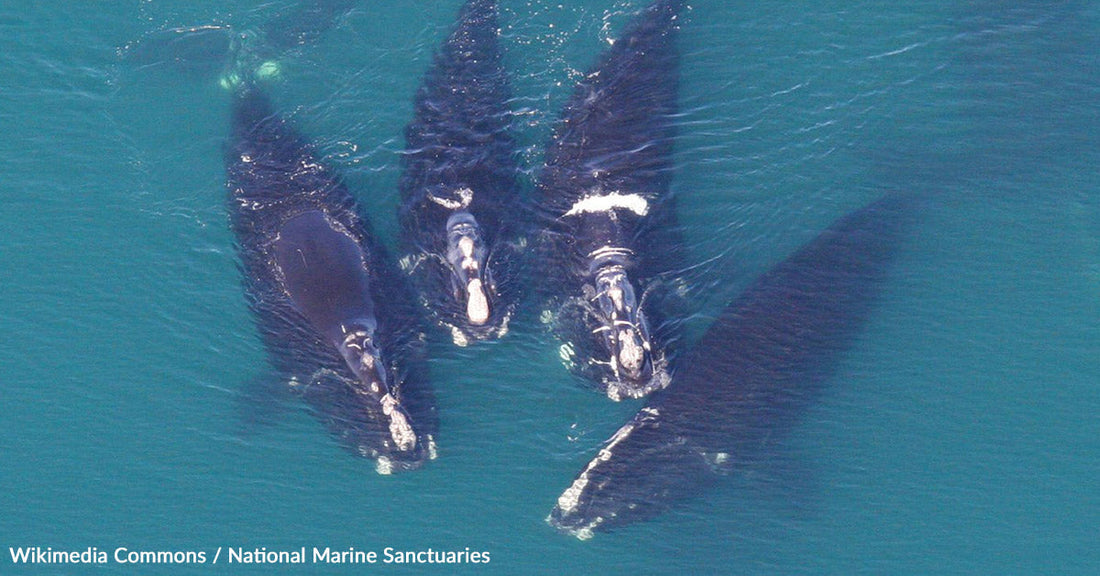Two Endangered Right Whales Make Stunning 2,700-Mile Journey Together
Matthew Russell
Two of the rarest whales on Earth, Koala and Curlew, recently completed an astonishing journey that defied expectations and marine biology textbooks alike.
These female North Atlantic right whales—part of a dwindling population of just 372—ventured thousands of miles through unfamiliar and sometimes perilous waters, from the Gulf of Mexico to the Canadian Atlantic, with one unprecedented stop in the Bahamas.
Their movements captivated scientists, conservationists, and everyday ocean-watchers not only because of the sheer distance traveled, but because of what their journey may reveal about the shifting behaviors and fragile status of their species.

Photo: Wikimedia Commons / National Marine Sanctuaries, License: Public Domain
Koala and Curlew are two critically endangered North Atlantic right whales.
A Journey That Defied Convention
Koala and Curlew were first spotted swimming together in late November 2024 off the coast of South Carolina. By January, they had been identified near Stuart, Florida, making their way south, far past typical migration routes, Ormond Beach Observer reports.
Their presence in the Gulf of Mexico stunned researchers. Right whales rarely enter those waters—there have been only a handful of documented cases since 2000, NOAA Fisheries confirms.
From February through April 2025, the pair lingered along Florida’s Panhandle, moving between Panama City Beach, Navarre, and Destin. The public was urged to report sightings as the whales hugged shallow coastal areas, appearing in good health but dangerously close to busy boating routes, National Fisherman reports.
By mid-April, the duo had passed the Florida Keys and surfaced near Bimini in the Bahamas, where they made history as the first documented right whales seen in that region, Mongabay reports. It’s a location nearly 1,200 miles off their expected path during spring.
Koala and Curlew’s remarkable pace—covering more than 400 miles in just four days—left even seasoned mariners stunned. As USA Today reports, the mystery only deepened when the pair vanished again for a month before resurfacing in the Gulf of St. Lawrence, north of Prince Edward Island.

Photo: Wikimedia Commons / National Marine Sanctuaries, License: Public Domain
They traveled over 2,700 miles across the Gulf of Mexico and Atlantic Ocean.
Tracking Whales in a Warming World
Each North Atlantic right whale is identified by unique callosity patterns on their heads. Koala, born in 2009, has markings that resemble a koala’s shape. Curlew, born in 2011, is named after a curved scar on her back, NOAA Fisheries reports. These identifying traits are documented in photo catalogs maintained by organizations like the New England Aquarium.
Right whale migrations generally stretch from the feeding grounds off New England and Nova Scotia to calving areas near Georgia and Florida. While scientists track them using aerial surveys and public reports, they remain deeply vulnerable. Vessel strikes and entanglements in fishing gear are leading causes of death, and over 85% of whales show signs of past entanglement injuries Ormond Beach Observer confirms.
Warmer ocean temperatures also threaten their survival. As Mongabay notes, the copepods these whales rely on for food are vanishing in warming waters, especially in the Gulf of Maine, which is heating four times faster than the global average.

Photo: Wikimedia Commons / Pcb21, License: Public Domain
Their journey included the first recorded right whale sighting in the Bahamas.
Rare Bonds and Uncertain Futures
Koala and Curlew’s long-term companionship is another anomaly. Right whales typically travel alone, except when accompanied by calves. Their synchronized movements over many months hint at a social bond not often seen between unrelated adults Ormond Beach Observer reports.
There were hopes that one or both might be pregnant. Photogrammetry assessments suggested a high likelihood for Curlew, but neither whale has been seen with a calf to date, according to NOAA Fisheries. That matters, because only 11 mother-calf pairs were documented during the recent calving season—far below the 20 needed annually to maintain current numbers, and well short of the 50 needed to recover the population, USA Today reports.
A Call to Watch—and Protect
From Flagler Beach to the Gulf of St. Lawrence, Koala and Curlew have sparked awe and urgent questions. Their unusual route may speak to environmental changes, instincts we don’t yet understand, or a sheer will to roam. Regardless, their trek through warming seas, busy shipping lanes, and unfamiliar territory is a reminder that every whale matters.
Anyone who spots a North Atlantic right whale is urged to call 877-WHALE-HELP, stay 500 yards away, and slow to 10 knots when whales are nearby. These steps aren’t just suggestions—they’re the front lines of survival for a species on the brink.

